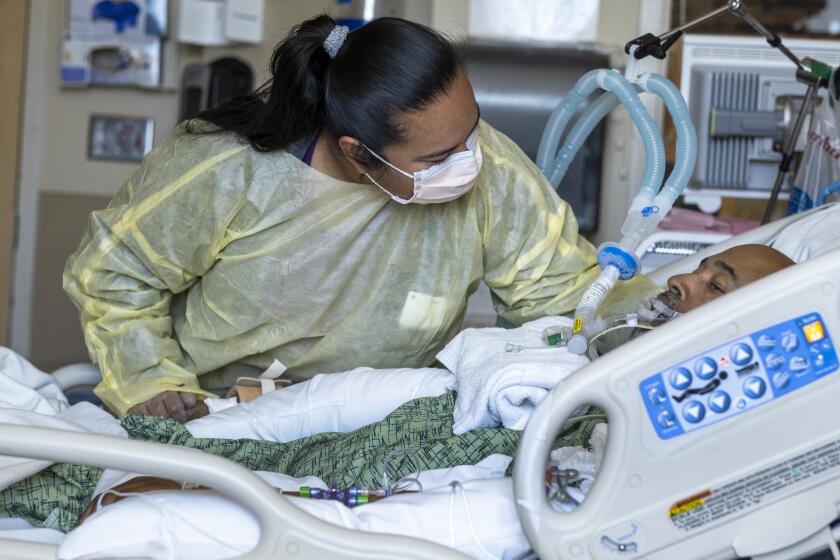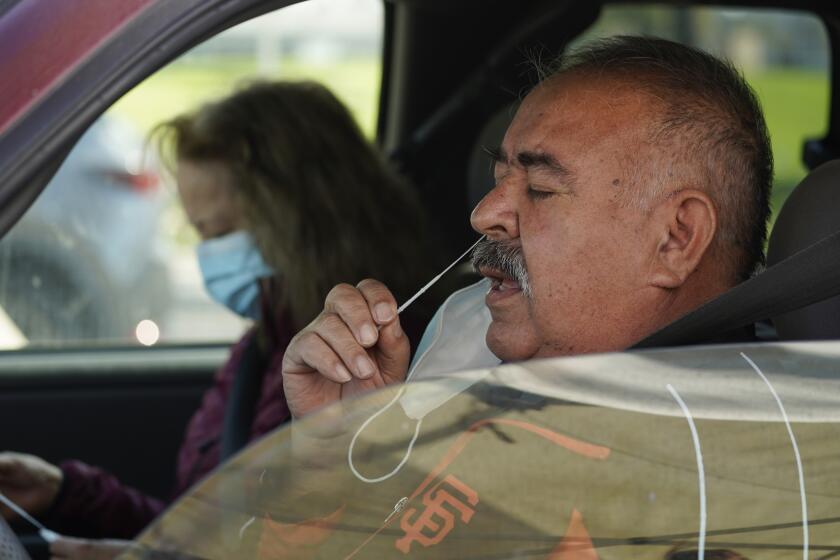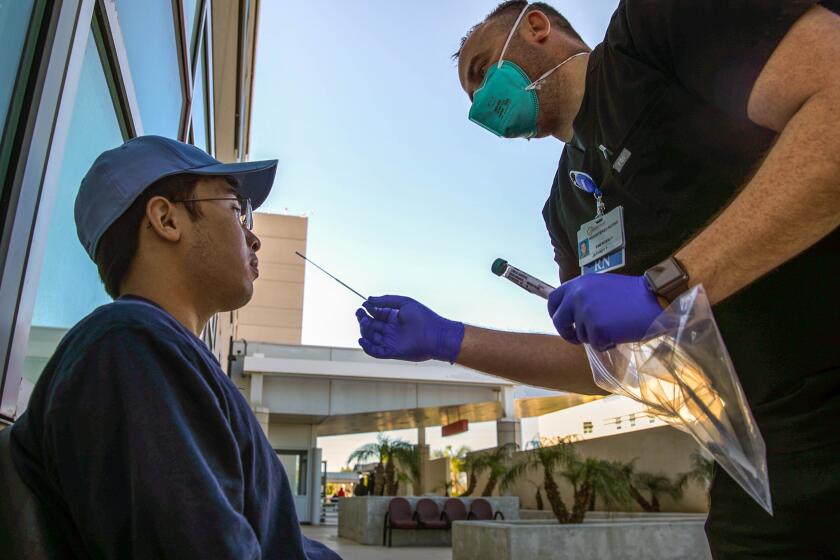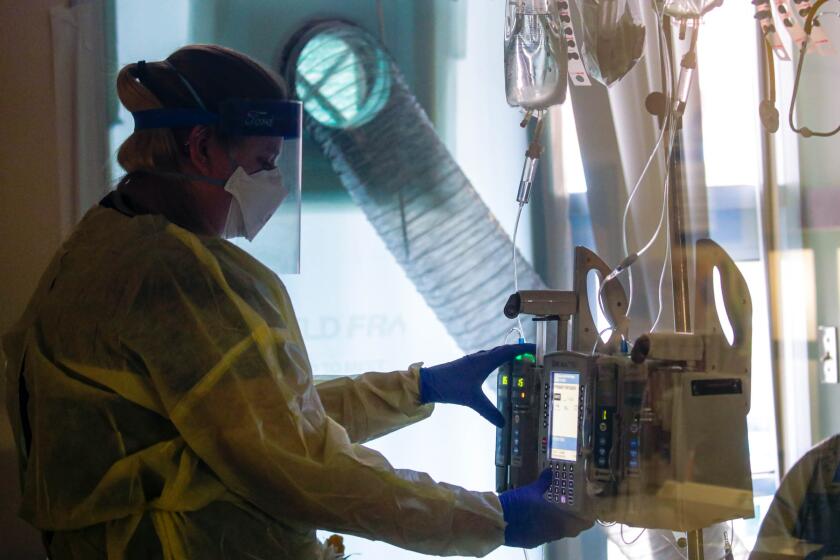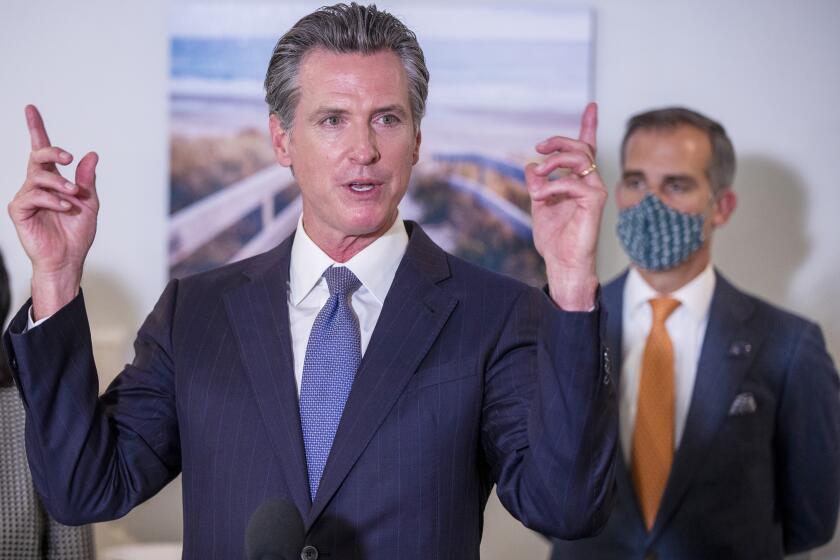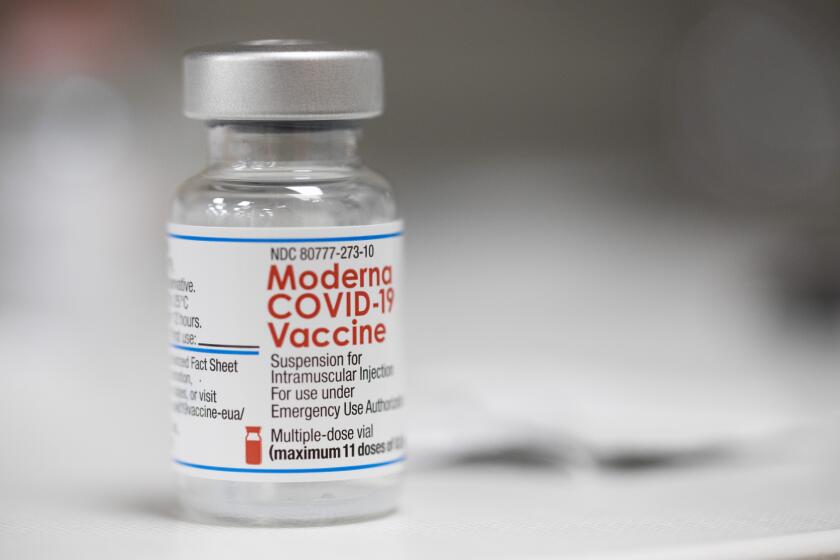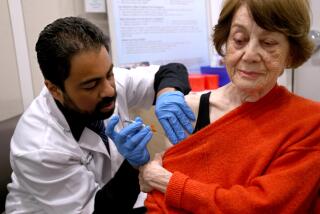Omicron hit Southern California much harder than the Bay Area. Here’s why
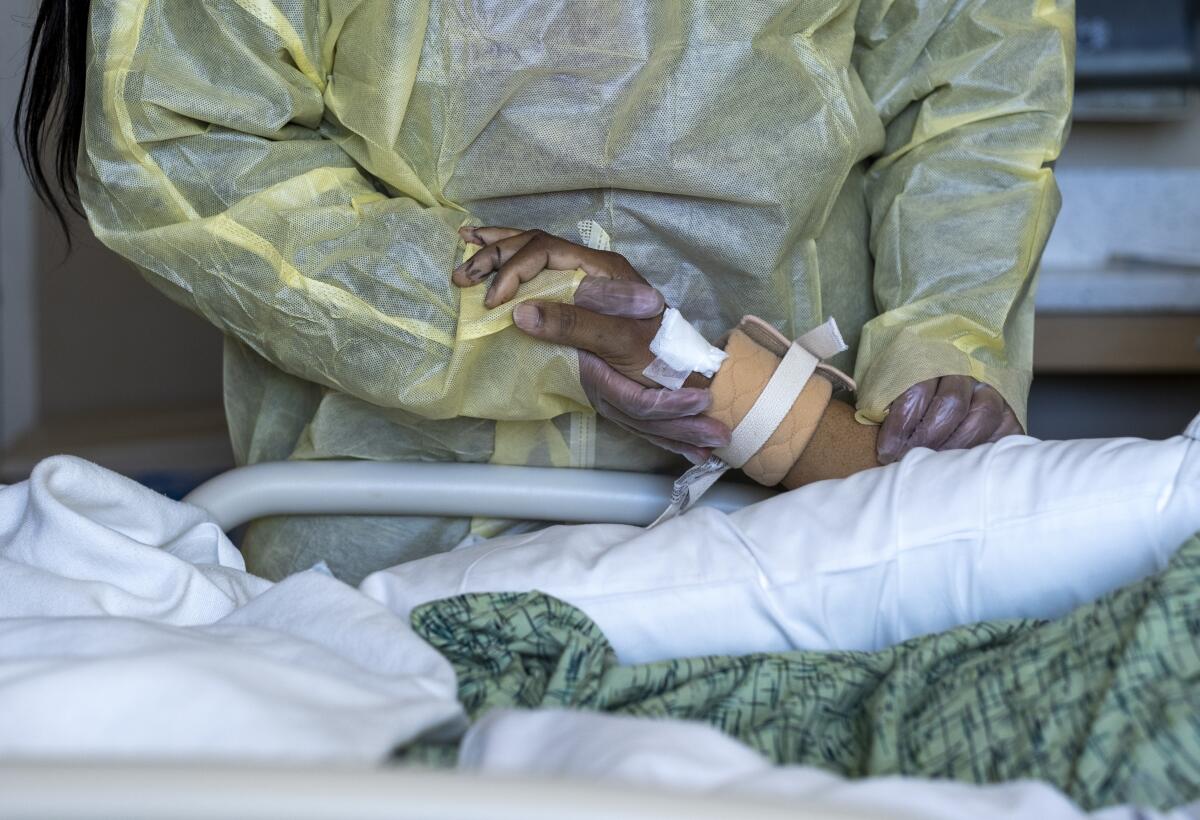
- Share via
SAN FRANCISCO — The Omicron wave took a much greater toll on Southern California compared to the San Francisco Bay Area, where higher vaccination levels contributed to significantly lower death rates, according to a Times data analysis.
Southern California’s COVID-19 death rate during January was three times worse than the Bay Area’s, the data show. More than 2,400 COVID-19 deaths have been recorded in Southern California since New Year’s Day, the equivalent of about 11 deaths for every 100,000 residents. In the Bay Area, the death rate was 4 per 100,000 residents, totaling just over 300 deaths.
This is the latest coronavirus wave where, compared to Southern California, the Bay Area has fared relatively better, and local officials this time credit high rates of vaccination and booster shots. Hospitals have also been able to maintain available capacity in San Francisco, while Southern California facilities have reported serious strain.
Dr. Eric Topol, director of the Scripps Research Translational Institute in La Jolla, said the differences in deaths “can largely be accounted for by these important differences in percent [of people] vaccinated and boosted. Undoubtedly, other factors contribute, but their impact is likely much less.”
San Francisco’s outlook is so optimistic, the city will ease its COVID-19 mask order on Tuesday for vaccinated gym members and office workers, allowing them to go maskless as long as they are up-to-date on booster shots, if they are eligible.
The county reported 16,835 new daily COVID-19 cases on Sunday, down from 26,354 cases a week ago, officials said
Being vaccinated and getting boosted are the best protection against severe COVID illness and death, health experts have repeatedly said. Unvaccinated people are 22 times more likely to die than boosted individuals, according to the California Department of Public Health.
“Because of our high vaccine rate, and because of our booster rate, we are not in a situation like other parts of the country that have lower vaccination rates, where there are very high numbers of death, where they’re not able to staff their hospitals adequately,” Dr. Grant Colfax, San Francisco’s director of health, said at a recent Board of Supervisors meeting.
According to the Centers for Disease Control and Prevention, 82% of San Franciscans and 84% of Santa Clara County residents are considered fully vaccinated. About half have received a booster shot in each county.
By contrast, in Los Angeles County, 70% of residents are fully vaccinated, and only about one-third have gotten a booster shot.
The highly contagious Omicron variant of the coronavirus is driving the daily American death toll higher than during last fall’s Delta wave.
And 3 million L.A. County residents haven’t received a booster even though they are eligible, said the county’s public health director, Barbara Ferrer.
“Most of those who are fully vaccinated and tragically die had severe co-morbidities, including being immunocompromised, and many had not received their booster dose,” Ferrer said last week.
In a recent blog post, Topol wrote that the poor uptake of boosters in the U.S. “has been frankly pathetic, largely a function of aggressive mis- and dis-information campaigns by anti-vaxxers and the politicization of vaccines (along with masks and other mitigating measures).”
“It is clear to me that some of the pronounced rise in hospitalizations and deaths could have been reduced by an early and aggressive booster campaign,” Topol wrote.
The CDC says the national COVID-19 death toll is about 882,000, with about 2,300 deaths added each day. Topol said that he expects the national death toll to exceed 900,000 within days, and that “it is now inevitable that we’ll soon see that toll rise to more than a million American lost lives, and we know that well over 90% of these deaths were preventable with vaccination.”
California has identified a number of cases of BA.2, a sublineage of the Omicron variant. How concerned should we be?
Higher vaccination and booster rates also explain the Bay Area’s lower coronavirus case rate in January, said Dr. Robert Kim-Farley, a UCLA epidemiologist and co-author of “Public Health Emergencies.” Southern California’s January coronavirus case rate was 30% higher than the Bay Area’s, according to The Times’ analysis.
The Bay Area’s numbers reflect “the impressive reductions in death rates that can be achieved through vaccination and where, eligible, boosting,” Kim-Farley said. It’s also likely that Bay Area residents are likelier to wear masks than Southern California residents, Kim-Farley said.
Recent research indicates that increased vaccinations and booster shots could have profoundly blunted the Omicron wave in L.A. County.
Modeling estimates from a team at USC studying the Omicron wave through mid-January say that L.A. County could have seen 85% fewer infections, and 87% fewer hospital admissions, if everyone eligible had been vaccinated. If everyone eligible had been boosted, there would’ve been 95% fewer coronavirus cases, and 98% fewer hospital admissions.
There remains considerable debate about the pandemic’s trajectory, but scientists generally say it’s too early to declare an ‘endgame’ for COVID-19.
A number of health experts say it’s possible more surges could come over the summer and next winter. While it’s unclear if they will be small or something far worse, officials say the likelihood of any surge is reason to get boosted now. Boosters are available to everyone 12 and older and at least five months removed from their second dose of Moderna or Pfizer-BioNTech; or two months past their single shot of Johnson & Johnson.
“It’s very possible that there can be another variant of concern in the future that can spread easily and contribute to another surge,” Ferrer said. “Vaccines do remain our best tool for preventing COVID-19. Getting as many people vaccinated as soon as possible can help us sustain the declines we’re seeing and limit opportunities in the future for new variants to arise.”
L.A. County’s vaccination and booster numbers are still better than the national rate, where 64% of U.S. residents are considered fully vaccinated, and only about one-quarter have received a booster shot.
“No matter how you cut this data, people who are unvaccinated are much more likely to get infected than people who are vaccinated, and especially than people who are vaccinated and boosted,” Ferrer said.
While that doesn’t mean vaccinated or boosted individuals are completely shielded from testing positive, she said, the driving force behind the latest surge remains those who have yet to roll up their sleeves.
“This is a pandemic. It is the most unusual circumstance that I hope any of us ever have to live through. It’s caused more death than anything else I can recall in my lifetime in this short span of time,” she said. “And we should continue to do everything we can to make sure that people are able to use the tools that we have, and that is vaccination and boosters right now.”
California is on the downslope of yet another coronavirus surge as it enters another season of celebration.
According to research published by the CDC, the Pfizer-BioNTech and Moderna vaccines were about 81% effective in preventing people from being hospitalized with Omicron within six months of a second dose. That typical effectiveness dropped significantly, to 57%, after six months.
But a subsequent shot restored that protective power, and then some — with effectiveness against hospitalization measured at 90% following a booster.
“It’s vital that we all remain vigilant in the face of this virus,” CDC Director Dr. Rochelle Walensky said during a recent briefing. “I know many people are tired, but many of our hospitals are still struggling beyond capacity. It’s been a long two years. However, please now do your part to lean into this current moment. Now is the time to do what we know works: Wear a mask, get vaccinated and get boosted.”
Other states appear to be faring worse than California in the past month. Florida’s January death rate is 36% worse than California’s; Texas’ is 48% worse; and New York’s is triple California’s, according to a Times analysis.
Florida and Texas have significantly lower rates of booster uptake than California. Another factor that might be helping California is the state’s relatively mild weather this January, in which residents in highly populated areas spent more time socializing outdoors than residents in colder states, according to Kim-Farley.
To be sure, a full analysis of the Omicron surge’s death rate will take a while to sort out. New York’s Omicron surge came earlier than California’s, which may partly account for why New York’s January death rate is so much larger than California’s.
Other regions of California also had worse COVID-19 death rates than the Bay Area’s. Rural Northern California and the Greater Sacramento area had death rates in January twice the Bay Area’s, while the San Joaquin Valley’s was three times as bad.
The group was attending the game that saw the Los Angeles Rams defeat the San Francisco 49ers to advance to the Super Bowl.
The San Joaquin Valley has also struggled with vaccination rates. In its most populous county, Fresno County, 59% of residents are fully vaccinated, and fewer than 1 in 4 residents have received a booster shot.
Intensive care unit bed availability in the San Joaquin Valley has fallen under 10% for six consecutive days, and surge protocols have been activated, “which allows flexibility to transfer patients to hospitals with additional ICU capacity,” the state Department of Public Health said Friday.
“ICUs in the San Joaquin Valley, where vaccination rates are lower, are nearing capacity. Californians will get through this latest surge by continuing to follow the science, including by getting vaccinated and boosted, which is the safest way to protect yourself from the virus,” Dr. Mark Ghaly, the state health and human services secretary, said in a statement.
Because of the strain on its medical facilities, Fresno County on Jan. 12 was forced to reinstate a program in which not everyone calling 911 is automatically transported to hospitals.
“We’re still experiencing this major surge,” said Dr. Rais Vohra, Fresno County’s interim health officer. “Day in, day out, the hospitals are seeing lots of unvaccinated individuals or people that aren’t caught up on their boosters come in, and they’re very sick.”
The decision was bolstered by real-world evidence from the more than 200 million doses administered in the U.S. since the FDA cleared the shot in December 2020.
Times staff writer Sean Greene contributed to this report.
More to Read
Sign up for Essential California
The most important California stories and recommendations in your inbox every morning.
You may occasionally receive promotional content from the Los Angeles Times.
